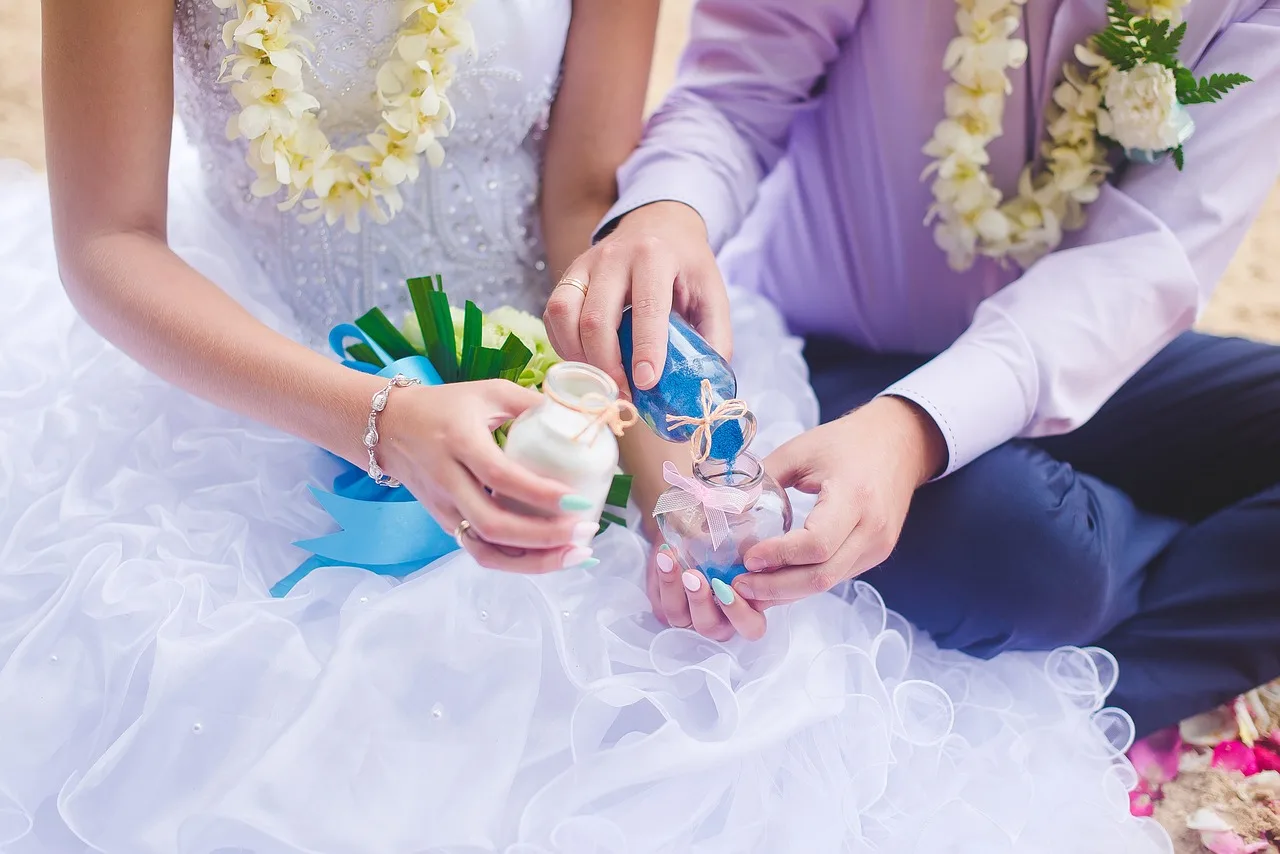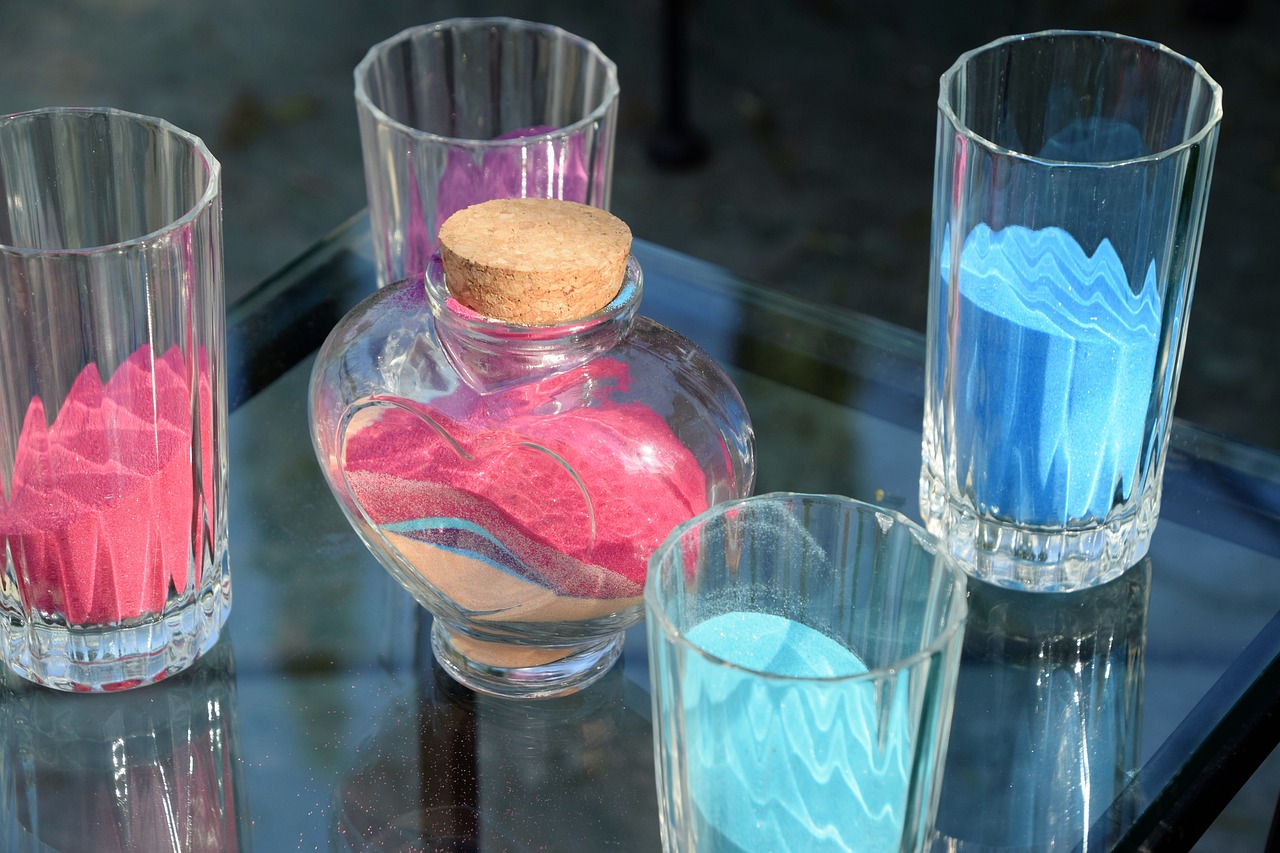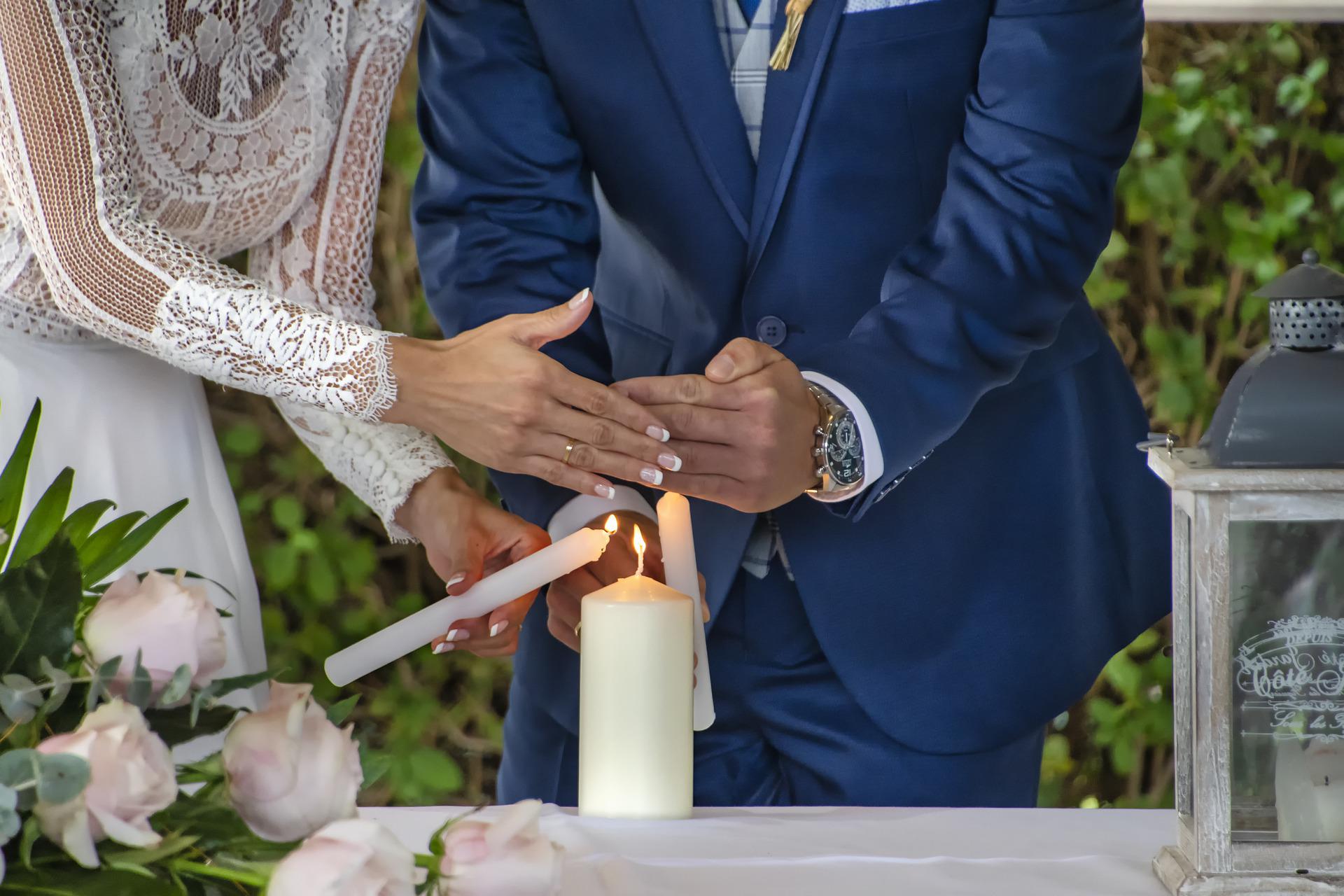Looking to add a unity tradition to your wedding day? Want a special keepsake from your ceremony? Or just a big fan of the beach? All good reasons to consider a sand ceremony!
What is a sand ceremony?
A sand ceremony is a unity tradition or ritual that can be added to a wedding ceremony. During the sand ceremony, there are two small vessels, each filled with sand, and one larger vessel, that is empty. The couple getting married will each pick up one of the smaller vessels of sand and pour them into the larger vessel, combining the grains of sand together.
This ritual symbolizes the joining of the couple and beginning of their marriage. It can also symbolize the joining of two families (more on how to incorporate family members into this ritual below). Many couples choose to use two different colours of sand, to represent two individuals coming together. As the colours mix, it signifies that the two individuals have become one.
Sand ceremonies first became popular in the 80’s as an alternative to the unity candle ceremony. As some venues don’t allow flames – and others, like a backyard on a windy day, make it hard for candles to stay lit – the sand ceremony offered a good alternative. It also provided a keepsake, as newlyweds were able to take the sand-filled vessels with them and display it in their homes.
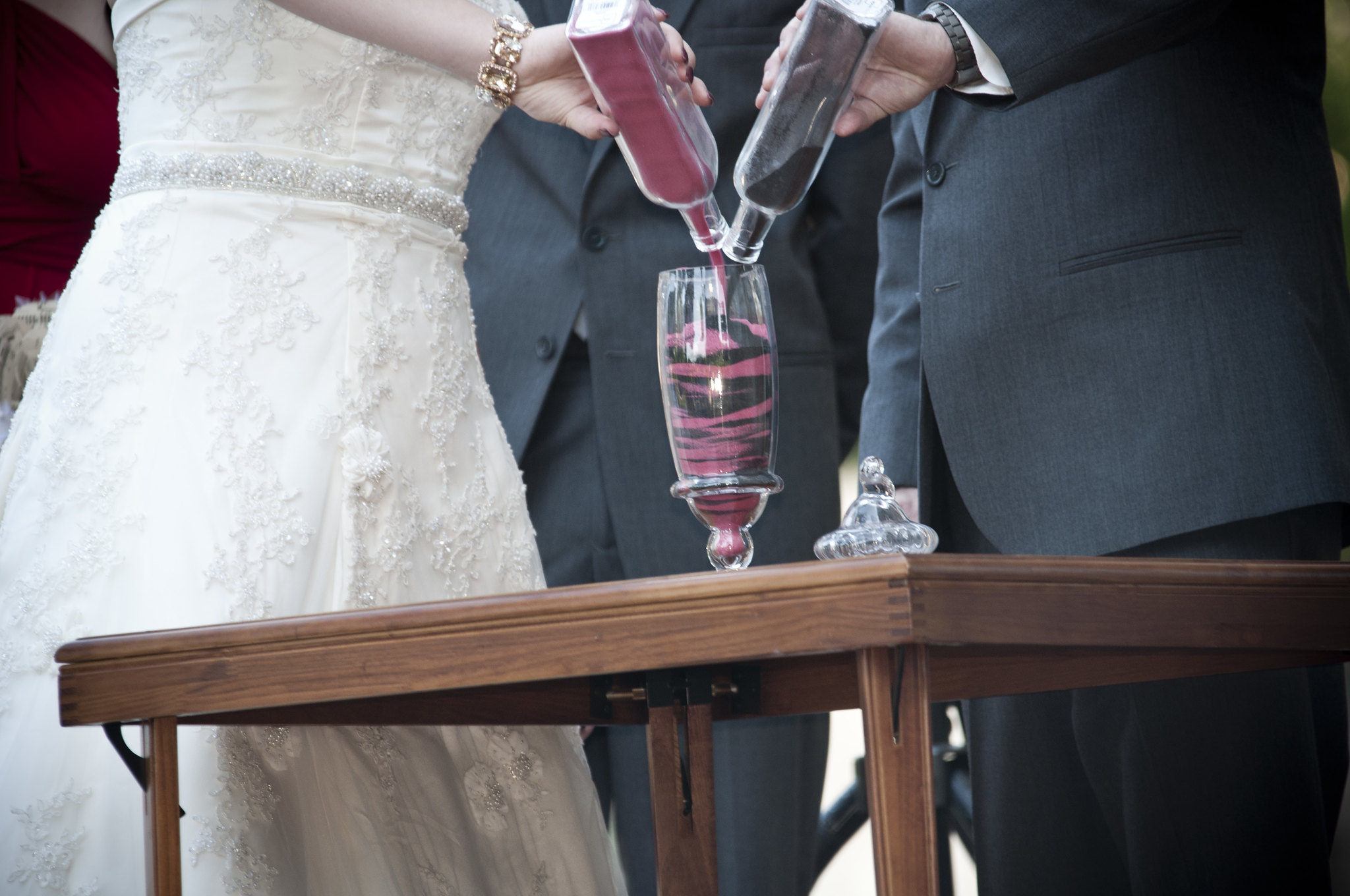
Who should do a sand ceremony?
While sand ceremonies may have started as a religious ritual (since their predecessor, unity candles, have Catholic origins), you do not have to be religious to incorporate a sand ceremony into your wedding day. This special ceremony is open to all couples!
Couples who want to add a unity tradition to their ceremony may want to consider a sand ceremony. It’s a beautiful way to represent the coming together of two people or two families. It also allows a couple to take a more active role in their ceremony and can be fun for guests to witness.
Couples who want a special keepsake from their wedding ceremony may also want to add in this sand ritual. Of course, you will leave your ceremony with rings, a signed marriage licence and a happy spouse. But if you also want a physical memento to display in your home and cherish for years to come, a sand ceremony is a good way to achieve that.
Lastly, if you have a special connection to sand, a sand ceremony may be perfect for you. For example, maybe you got engaged on the beach or grew up on the coast.
What materials do you need for a sand ceremony?
To hold a sand ceremony you need:
- Sand (duh!): Most couples choose two different colours of sand but this isn’t required. You can collect sand from a local beach or buy coloured sand from a craft store.
- Two vessels to hold the sand at the beginning of the ceremony: These vessels are usually smaller and more simple than the larger vessel that will hold the sand at the end of the ceremony.
- One larger vessel to pour the sand into: Make sure that this vessel is large enough to hold the full contents of both small vessels. This larger vase or vessel is usually see-through, so you can see the sand mixing, and generally more ornate than the smaller vessels, since it’s the keepsake piece.
- Something to close and safely transport the larger vessel: Don’t forget about these items! You’ll want to make sure you have a stopper or lid to keep the vessel of sand from spilling. You may also need materials to safely pack it up and get it back to your house, such as bubble wrap, a box, etc.
In addition to materials, you’ll also want to come up with a plan for how to pull off your sand ceremony. You’ll need to know how the sand and other materials are getting to the venue, who is arranging them at the front, what they will sit on, and how they’ll get back home. You’ll also want to discuss with your wedding officiant how and when the sand ritual will happen during your ceremony. More on that below!

When does the sand ritual happen during a wedding?
There isn’t a specific time when a sand ceremony needs to happen. The timing is flexible and you can speak with your wedding officiant about when makes the most sense for your ceremony.
Typically you’ll want to do the sand ceremony around the same time as you exchange rings, as part of an overall unity tradition, since both symbolize your new bond. The ring exchange usually happens after your vows and before your kiss and the pronouncement of you as a married couple.
Sand ceremony script outline
During the sand ceremony portion of your wedding, your officiant will explain to your guests what’s happening and facilitate the ritual for you. Here’s an example of a sand ceremony script your wedding officiant might follow:
Wedding officiant: “Bella and Edward will now symbolize the joining of their two families with the joining of sand. Bella and Edward, I invite you to receive the sand from your parents and pour it together into this vase.”
Edward and Bella receive small vases of sand from their parents. They pour that sand into a larger vase on a table in front of them.
Wedding officiant: “Just as these grains of sand can never be separated and poured again into the individual containers, so too will your marriage and your family forever be intertwined.”
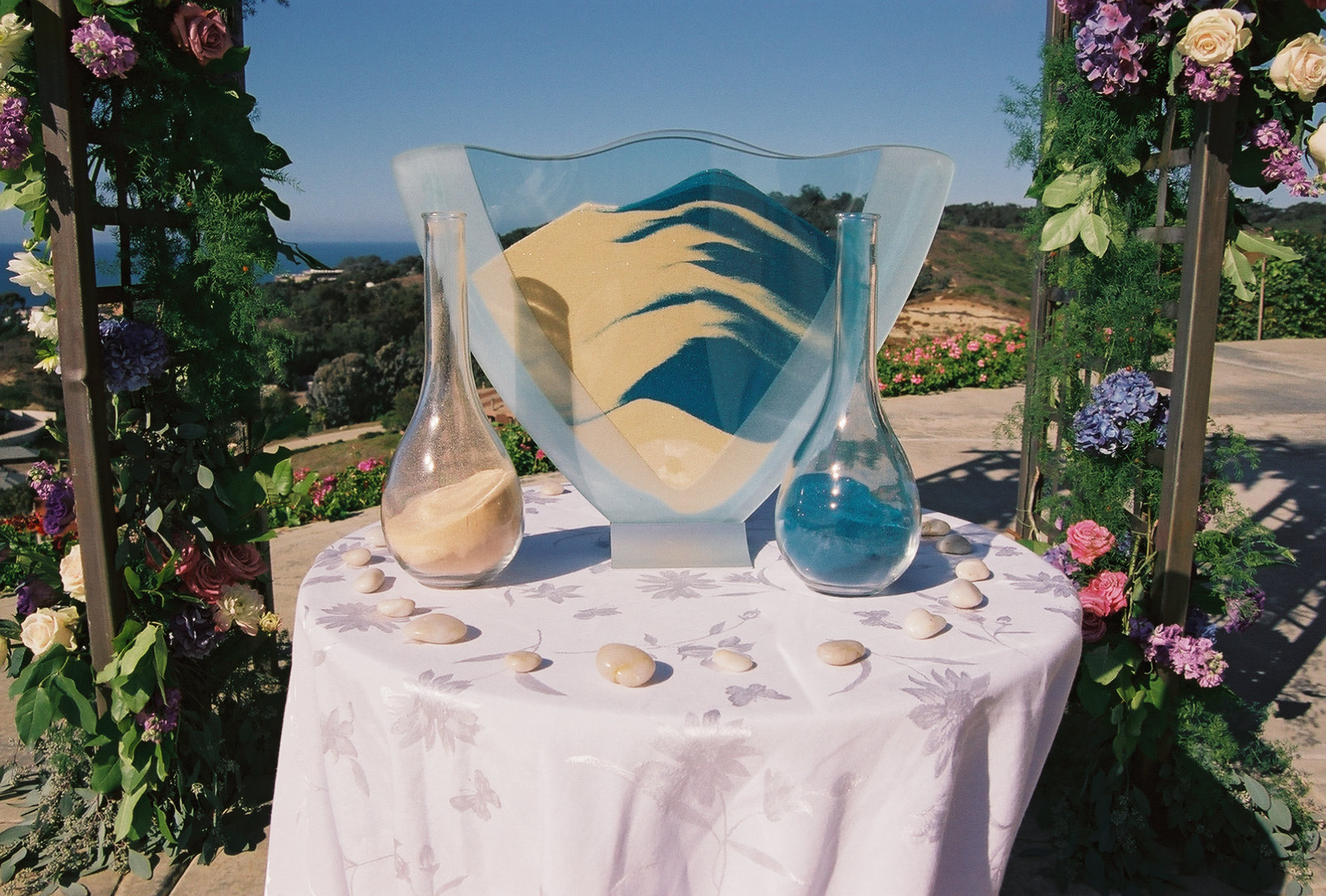
Unity sand ceremony variations
Not only are sand ceremonies beautiful traditions but they leave lots of room for creativity and personalization. Here are a few variations you may want to make with your sand ceremony:
- Use sand that you’ve collected from special places. For example, you may want to use sand that you’ve collected from past vacations, the beach where you got engaged, or the coast where you grew up. This can be a subtle yet significant way to personalize your sand ritual.
- Involve your children. Rather than just having the newlywed couple pour sand, you could invite the whole family to join you. For example, if you’re blending a family, you might ask each child to pour sand into the large vessel to symbolize your family coming together.
- Involve your families. If you like the idea of the sand ceremony representing two families joining together, you can involve your parents, grandparents, siblings or other loved ones in the ritual. For example, you could have your families each fill the smaller vessels of sand, symbolizing the love and care they poured into you, before you and your spouse pour them into the larger vessel together.
- Choose a special vessel. Rather than just pour the sand into a regular vase or mason jar, why not choose one with special meaning? You can get a vase engraved with your names and wedding date or use a family heirloom.
- Turn your vase into a piece of art. Some couples choose to pour their sand into a glass vase and then bring it to a glassblower, who then turns it into a sculpture, dish, ornament or other piece of art. Some glassblowers even offer workshops where the newlywed couple can take part in creating their sand ceremony art piece.
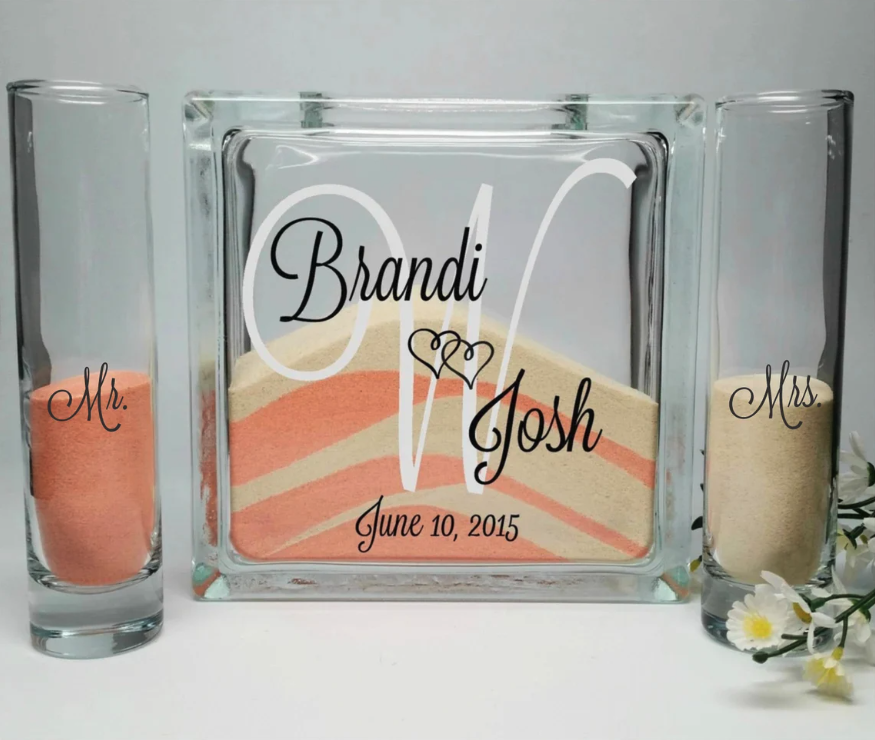
What other unity ceremonies can we add to our wedding?
Not sure a sand ceremony is for you? Luckily there are lots of unity ceremonies and traditions you can choose from. Other unity ceremonies include:
- Ring warming: Guests are invited to “warm” the couples’ rings before the ring exchange with their love and well wishes. This usually happens before the ceremony, with the rings available for guests to see and touch, or during the ceremony, as the rings are passed from guest to guest.
- Handfasting: In a handfasting ceremony, the newlyweds’ hands are bound together by cord to symbolize their commitment and a literally “tying of the knot.” The cords can then be taken home as a keepsake.
- Unity candle: Each member of the couple takes a small candle and uses it to light a larger candle together during a unity candle ceremony. This is historically a religious wedding practice but can be done in secular or non-denominational weddings too.
- Beer blending: For couples who enjoy an adult beverage, try this twist on a unity ceremony. Each person will take a different type of beer and pour it together into one glass, blending the beers. This can also be done as a wine blending for vino lovers. Both lead perfectly into a wedding ceremony toast!
- Community vow: If you’d like to incorporate your guests into your union, why not add a community vow? In this ritual, your officiant will read a vow out to your guests and ask them to say “we do” if they agree to support your marriage. It’s a nice way to get guests involved and feel the love all around you.
- Anniversary capsule: Some couples choose to put together an anniversary capsule as their unity tradition. This usually involves putting special items into a box, such as wine and love letters, to be opened on your first wedding anniversary.
- Tree planting: For couples with green thumbs, why not plant a tree during your wedding ceremony? As most ceremonies don’t take place in the forest, this is usually done on a smaller scale with a potted tree that couples can plant together. You can then bring the tree home as a houseplant or plant it locally in your area and watch it grow over the years.
- Paint blending: Another unity option for artsy couples is paint blending. Similar to a sand ceremony, each member of the couple will have a jar of paint and pour them together on a canvas to create a multi-coloured drip painting. Just be careful not to spill any paint on your wedding outfits!
- Or make up your own unity ceremony! If there’s something special you’d like to do at your wedding ceremony to symbolize your commitment and unity, why not add it in? Talk it over with your wedding officiant to find out how to best incorporate it into your wedding day.
Whether you decide a sand ceremony is right for your wedding, choose another unity tradition, or skip the rituals altogether, you want to plan a wedding ceremony that feels authentic to you.
And the best way to do that? With a Young Hip & Married wedding officiant and ceremony package, of course! Find our more and book yours today!
